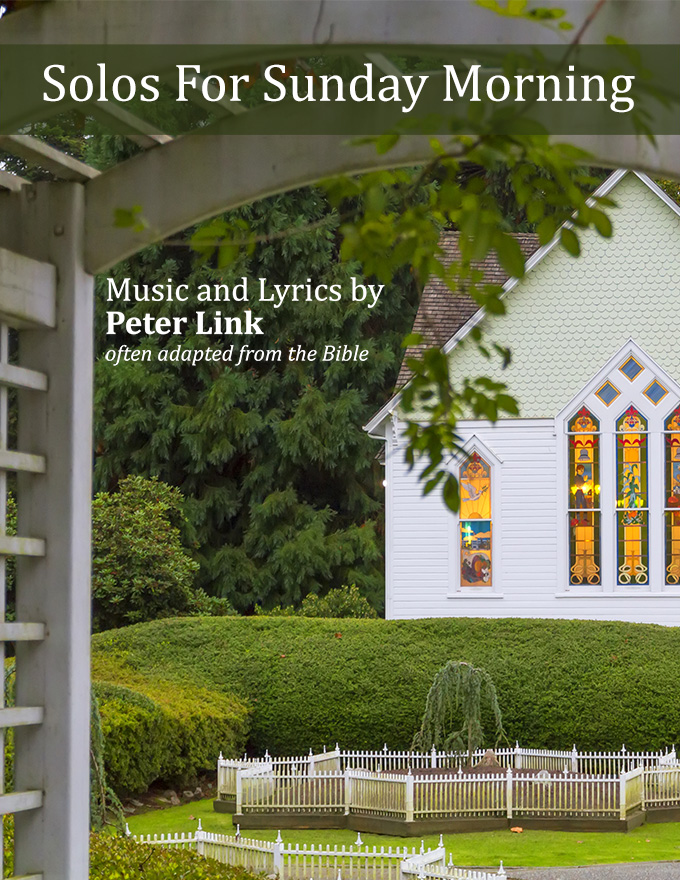Stretch Yourself! - Part 1
Several years ago, I began to write about the learning process that we performers go through to learn a song, a scene, a role, an entire concert or show.
It’s time to share again! I am going to start here by writing about Study Tools that I have used over the years that have truly aided me in my preparation for performing.
Why talk about it now? Well, this has come to the forefront of our thought at Watchfire Music with the release, this past weekend, of Peter Link’s new “Solos For Sunday Morning” Song Bundle (digital song book). It’s a wonderful collection of 13 new songs composed especially for church soloists. You can explore the songs here!
Peter Link not only composed the music and wrote or adapted the lyrics for these songs, but he also provided a whole set of Study Tools – Study Tracks and Accompaniment Tracks for each song -- and for each key version of each song! Offering these Study Tools, however, is not a new practice at Watchfire Music. Many of our composers include the same kinds of Study Tools to enhance the learning of their sheet music. Just check out Rebecca Minor, Ann Stephan, Peter B. Allen, Tara Buzash, Simon Clark,Amy Duncan, Carolyn Kardinal, Ruth Lambert, Elizabeth Ragsdale, Robert Collister, April Brahinsky-- and so many more! These composers' Study Tools come in various forms and formats.
You might ask why this is important for professional singers. Well, church musicians, in particular, are being asked to cover more genres of music today in their solo repertoire, than ever before.
From a historical point of view, traditional church music's roots are grounded in classical music. (This does not include the Gospel and Southern Gospel music traditions in the United States).
Today, there is a plenitude of wonderful new and contemporary music being composed especially for church services that require new or different skill sets that classically trained singers may or may not be accustomed to using.
To get this conversation started, here is an excerpt from “Stretch Yourself,” an article published by Watchfire Music and included as part of a free Informational PDF download in Peter’s Solos For Sunday Morning Song Bundles. You can also download it here too.
Here's the first excerpt:
Stretch Yourself!
An Exercise In Expanding Your Approach To Music
The 21st Century Church Musician's Dilemma
The Problem One of the biggest obstacles to introducing contemporary music to church musicians and their congregations is the fear that some musicians have in being out of their comfort zone while performing rhythmically challenging music – a hallmark of many 21st century musical styles.
And yet, progress is a must in our church services. If we expect to bring our 21st century congregations to our church services, we must present accessibility and combine the classic with the new.
There is not a great deal of training for performing this newer kind of church music for the classical musician who is traditionally hired for these kinds of church services. How do we make this transition into new territory without fearing the skillset required to do so?
Our Solution We understand this problem, having spent many years performing in large and small churches all over the country and providing new music. Experience has taught us that we need to help church
musicians by providing study tools with the new music titles to aid the musicians’ preparation.
Here’s how we can help you …
Study Tools
For Excellent Preparation And Performance
The “Solos For Sunday Morning” Song Bundle offers Study Tracks and Accompaniment Tracks.
Why are these important? Well, probably the single most difficult aspect of transitioning from classical into more contemporary styles of music is the syncopated rhythms.
To aid you in your work, we offer these well-crafted Study Tools just for you -- the emerging 21st century church musician who, by and large, has trained classically, but find yourself needing to broaden and expand your repertoire for the modern church congregation.
We provide you with the same kinds of tools that great contemporary vocalists use all the time: Tools for your ears as well as for your eyes.
Sheet music isn’t always enough.
Modern ear training tools will quickly help you become more facile in singing and playing syncopated rhythms, and you will automatically increase your skill in feeling the meter, keeping time, reading rhythms, and understanding the original intent of the composer.
How does that work? By listening.
Think about growing up listening to the radio or more often today, plugged into iPods and Androids, listening to music as you go through your life.
Do you find yourself easily humming, singing, or whistling the tunes coming through to you?
Why not try plugging into a Study Track or Accompaniment Track as you run, do errands, clean the house, or cook?
Why not listen to that music and get deep into the rhythms, harmonies and melodies as you go about your life?
Listen to the Accompaniment and Study tracks the way you listen to your iPod or the radio.
When you do this listening work, you will then come back to the visual roadmap of the sheet music with a whole new understanding. Your ears will inform your eyes of the musical notation splashed across the page!


